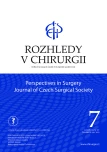Diagnosis and treatment of surgical skin and soft tissue infections – current status
Authors:
J. Ulrych 1; V. Adámková 2
; R. Gürlich 3; M. Kolář 4
; H. Lahoda-Brodská 5; V. Třeška 6; L. Veverková 7
Authors place of work:
I. chirurgická klinika – hrudní, břišní a úrazové chirurgie, Všeobecná fakultní nemocnice a 1. lékařská fakulta, Univerzity Karlovy v Praze
1; Klinická mikrobiologie a ATB centrum, Ústav lékařské biochemie a laboratorní diagnostiky VFN, Praha
2; Chirurgická klinika Fakultní nemocnice Královské Vinohrady a 3. lékařské fakulty Univerzity Karlovy v Praze
3; Ústav lékařské mikrobiologie Lékařské fakulty Univerzity Palackého Olomouc
4; Ústav lékařské biochemie a laboratorní diagnostiky Všeobecné fakultní nemocnice, Praha
5; Chirurgická klinika Fakultní nemocnice Plzeň a Lékařská fakulta Univerzity Karlovy, Plzeň
6; I. chirurgická klinika Fakultní nemocnice u sv. Anny a Lékařská fakulta Masarykovy univerzity Brno
7
Published in the journal:
Rozhl. Chir., 2022, roč. 101, č. 7, s. 300-311.
Category:
Souhrnné sdělení
doi:
https://doi.org/10.33699/PIS.2022.101.7.300–311
Summary
Surgical skin and soft tissue infections (SSTIs) result from microbial invasion of the skin and underlying soft tissues, often requiring surgical treatment. SSTIs encompass a variety of pathological conditions, ranging from frequent simple superficial skin infections with very good outcomes to rare, rapidly progressive necrotizing infections associated with long-lasting morbidity and high mortality. The document summarizes current knowledge of the diagnosis and therapy of these diseases and provides clinicians with current standards of care of these patients based on international guidelines. Additionally, regional specific aspects are also reflected, and thus in all cases, this paper on diagnostic-therapeutic management of individual clinical forms respects the actual clinical practice and epidemiology in the Czech Republic. The document has been prepared based on multidisciplinary consensus of experts from universities all over the Czech Republic.
Keywords:
diagnosis – treatment – skin and soft tissue infections – SSTI
Zdroje
1. https://www.uzis.cz/res/f/008357/hospit2019. pdf/str.45
2. Sartelli M, Malangoni MA, May AK, et al. World Society of Emergency Surgery (WSES) guidelines for management of skin and soft tissue infections. World J Emerg Surg. 2014;9(1):57. doi:10.1186/1749-7922-9-57.
3. Jenkins TC, Knepper BC, Jason Moore S, et al. Microbiology and initial antibiotic therapy for injection drug users and non-injection drug users with cutaneous abscesses in the era of community - associated methicillin-resistant Staphylococcus aureus. Acad Emerg Med. 2015;22(8):993–997. doi:10.1111/ acem.12727.
4. Moet GJ, Jones RN, Biedenbach DJ, et al. Contemporary causes of skin and soft tissue infections in North America, Latin America, and Europe: report from the SENTRY Antimicrobial Surveillance Program (1998–2004). Diagn Microbiol Infect Dis. 2007;57(1):7–13. doi:10.1016/j. diagmicrobio.2006.05.009.
5. Tiemersma EW, Bronzwaer SL, Lyytikäinen O, et al. European Antimicrobial Resistance Surveillance Systém Participants. Methicillin-resistant Staphylococcus aureus in Europe, 1999–2002. Emerg Infect Dis. 2004;10(9):1627–34. doi:10.3201/ eid1009.040069.
6. https://www.ecdc.europa.eu/sites/default/ files/documents/Country%20summaries - AER-EARS-Net%20202019.pdf
7. Sartelli M, Guirao X, Hardcastle TC, et al. 2018 WSES/SIS-E konsensus conference: recommendations for the management of skin and soft-tissue infections. World J Emerg Surg. 2018;13 : 58. doi:10.1186/ s13017-018-0219-9.
8. Stevens DL, Bisno AL, Chambers HF, et al. Practice guidelines for the diagnosis and management of skin and soft tissue infections: 2014 update by the Infectious Diseases Society of America. Clin Infect Dis. 2014;59(2):e10–52. doi:10.1093/cid/ ciu444.
9. Sartelli M, Coccolini F, Kluger Y, et al. WSES/ GAIS/WSIS/SIS-E/AAST global clinical pathways for patiens with skin and soft tissue infections. World J Emerg Surg. 2022;17(1):3. doi:10.1186/s13017-022-00406-2.
10. Lipsky BA, Aragón-Sánchez J, Diggle M, et al. IWGDF guidance on the diagnosis and management of foot infections in persons with diabetes. Diabetes Metab Res Rev. 2016;32 Suppl 1 : 45–74. doi:10.1002/ dmrr.2699.
11. Abrahamian FM, Goldstein EJ. Microbiology of animal bite wound infections. Clin Microbiol Rev. 2011;24(2):231–246. doi:10.1128/CMR.00041-10.
12. Tessier JM, Sanders J, Sartelli M, et al. Necrotizing soft tissue infections: A focused review of pathophysiology, diagnosis, optative management, antimicrobial therapy, and pediatrics. Surg Infect (Larchmt). 2020;21(2):81–93. doi:10.1089/sur.2019.219.
13. van Stigt SF, de Vries J, Bijker JB, et al. Review of 58 patients with necrotizing fasciitis in the Netherlands. World J Emerg Surg. 2016;11 : 21. doi:10.1186/s13017 - 016-0080-7.
14. Gatti M, Gasparini LE, Laratta M, et al. Intensive multidisciplinary management in critical care patiens affected by severe necrotizing soft tissue infections: a cooperative method to improve the efficacy of treatment. Eur J Clin Microbiol Infect Dis. 2019;38(6):1153–1162. doi:10.1007/ s10096-019-03521-2.
15. Levett D, Bennett MH, Millar I. Adjunctive hyperbaric oxygen for necrotizing fasciitis. Cochrane Database Syst Rev. 2015;1(1):CD007937. doi:10.1002/14651858.CD007937.pub2.
16. Hua C, Bosc R, Sbidian E, et al. Interventions for necrotizing soft tissue infections in adults. Cochrane Database Syst Rev. 2018;5(5):CD011680. doi:10.1002/14651858.CD011680.pub2.
17. Hakkarainen TW, Kopari NM, Pham TN, et al. Necrotizing soft tissue infections: review and current concepts in treatment, systems of care, and outcomes. Curr Probl Surg. 2014;51(8):344–362. doi:10.1067/j. cpsurg.2014.06.001.
Štítky
Chirurgie všeobecná Ortopedie Urgentní medicínaČlánek vyšel v časopise
Rozhledy v chirurgii

2022 Číslo 7
- Metamizol jako analgetikum první volby: kdy, pro koho, jak a proč?
- Perorální antivirotika jako vysoce efektivní nástroj prevence hospitalizací kvůli COVID-19 − otázky a odpovědi pro praxi
- Fixní kombinace paracetamol/kodein nabízí synergické analgetické účinky
Nejčtenější v tomto čísle
- Současná diagnostika a léčba chirurgických infekcí kůže a měkkých tkání
- Obří agresivní intraabdominální fibromatóza desmoidního typu kazuistika
- Laparoskopická sutura perforovaného peptického vředu – rutina, nebo cílený výběr pacientů?
- Benigní stenóza společného žlučovodu po Roux-Y gastrektomii

